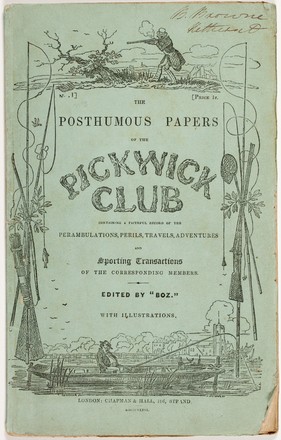The posthumous papers of the Pickwick Club
1837
Printed book
London: Chapman and Hall
Bequest of Sir William Dixson, 1952
SAFE/ 83/402–403
This is a perfect set of the first issue of Charles Dickens’ first novel, which he began at the age of 24. Each part is in its original green paper covers and contains illustrations by Hablot Knight Browne, who used the nickname ‘Phiz’.
With the subtitle ‘containing a faithful record of the perambulations, perils, travels, adventures, and sporting transactions of the corresponding members’, the novel tells a series of loosely related comic adventures about the members of a fictitious club, founded by the lead character, Samuel Pickwick. It is based on a series of captions Dickens was commissioned to write to accompany a series of illustrated ‘cockney sporting’ plates, drawn by Robert Seymour and published by Messrs Chapman and Hall.
The novel quickly became a phenomenal publishing success, and in 1838 the first pirated edition was printed by Henry Dowling of Tasmania and issued in 25 parts from August to December. During a trip to London in 1923, Sir William Dixson also purchased the Tasmanian pirate edition for £350. It is now the only known complete set in parts of the 1838 pirated edition.
Serial success
Serialised novels became increasingly popular in the 19th century. Far cheaper to print, they reached a much greater audience at only sixpence an issue, with an entire novel costing only around 20 shillings at the end of the serialisation. Writing novels as serials also allowed the author to test and respond to the mood of the readers; just like a modern-day soap opera, the author could change a storyline or finish off a character on an episode-by-episode basis.
Dickens published all of his 15 novels in serial form, in monthly parts combined with illustrations and advertisements. In March 1836, his publisher printed 1000 copies of the first instalment of The Posthumous Papers of the Pickwick Club; 40,000 copies of the final instalment were printed in 1937.
Hoping to capitalise on the novel’s popularity, Henry Dowling, a printer in Launceston, had the parts of Dickens serialised novel sent from London. Without any attempt to gain permission, Dowling re-issued the novel in 25 parts between August and September 1838. The lithographed illustrations of the Dowling issues did not appear until some weeks later and were then presented gratis to subscribers. These illustrations, which are signed ‘Tiz’ in imitation of ‘Phiz’ in the London issue, are generally considered to have been the work of Jack Briggs, a servant of Dowling.
The Pickwickians
‘The first ray of light which illumines the gloom, and converts into a dazzling brilliancy that obscurity in which the earlier history of the public career of the immortal Pickwick would appear to be involved, is derived from the perusal of the following entry in the Transactions of the Pickwick Club, which the editor of these papers feels the highest pleasure in laying before his readers, as a proof of the careful attention, indefatigable assiduity, and nice discrimination, with which his search among the multifarious documents confided to him has been conducted ...’*
Footnotes
* C Dickens, The Posthumous Papers of the Pickwick Club, 1837, chapter 1, ‘The Pickwickians’



 Back to list
Back to list